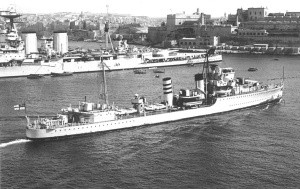I-class destroyer

The flotilla leader Inglefield
|
|
| Class overview | |
|---|---|
| Name: | I class |
| Operators: | |
| Preceded by: | G and H class |
| Succeeded by: | Tribal class |
| In commission: | 1937–1960 |
| Completed: | 13 |
| Lost: | 6 |
| Scrapped: | 7 |
| General characteristics (as built) | |
| Type: | Destroyer |
| Displacement: | |
| Length: | 323 ft (98.5 m) |
| Beam: | 33 ft (10.1 m) |
| Draught: | 12 ft 5 in (3.8 m) |
| Installed power: |
|
| Propulsion: | 2 shafts; 2 geared steam turbines |
| Speed: | 36 knots (67 km/h; 41 mph) |
| Range: | 5,530 nmi (10,240 km; 6,360 mi) at 15 knots (28 km/h; 17 mph) |
| Complement: | 137 (peacetime), 145 (wartime) |
| Sensors and processing systems: |
ASDIC |
| Armament: |
|
The I-class destroyers were a group of nine destroyers, including a flotilla leader, built for the Royal Navy during the 1930s. Four similar ships were ordered by the Turkish Navy, of which two were purchased for the Royal Navy, bringing the total number of these ships in that service to 11—although three of the original ships had been lost by the time Inconstant and Ithuriel commissioned. They served in World War II and six were lost, with a seventh ship being written off as a constructive total loss.
The Is were a repeat of the preceding H class, except that they had ten torpedo tubes (two banks of five) instead of eight. They incorporated the new bridge and wheelhouse layout as trialled in Hero and Hereward (except the flotilla leader Inglefield). Inglefield also had a larger tripod foremast, her sisters having pole masts. The extra weight of the torpedo tubes and fitting both minesweeps and depth charge gear (previous vessels carried one or the other) on the same hull as the H class caused a loss of stability, resulting in the need to ballast when bunker levels were low.
All ships were fitted for minesweeping and with depth charges and Asdic for anti-submarine (A/S) work and were capable of conversion to minelayers. For this, they landed 'A' and 'Y' 4.7 inch guns, the torpedo tubes and their minesweeps, allowing carriage of up to 60 mines, however only four ships ever served in this role (see below).
The Turkish I-class ships were of a similar design to their British counterparts, but shipped only eight torpedoes (two banks of four), like the British H class.
Early war modifications involved replacing the after bank of torpedoes with a single QF 12 pounder (3 inch/76 mm) anti-aircraft (AA) gun, cutting down the after funnel and mainmast to improve the former weapon's field of fire and adding a pair of QF 20 mm Oerlikon guns in the bridge wings. Radar Type 286, a metric wavelength surface-warning set, was added as it became available, and the ineffective multiple 0.5-inch (13 mm) Vickers machine guns were replaced with further Oerlikons; the central tube was deleted from the torpedo launchers to lessen topweight. Icarus lost 'Y' gun to stow extra depth charges (for a total load of 110) and their mortars. Surviving ships received a third pair of Oerlikons, added abreast the searchlight position, and the 12 pounder gun was deleted to increase depth charge stowage. In some ships, 'A' gun was replaced with a Hedgehog ahead-throwing A/S weapon, but this alteration seems to have been reversed at a later stage. Ilex, Intrepid, Impulsive and Isis had 'B' gun removed and two QF 6 pounder 10 cwt (2.25 inch/57 mm L/47) guns were added, on the twin mounting Mark I* along with a Hedgehog, the former for anti-E boat work.
...
Wikipedia
